Córugud and Compilatio in Some Manuscripts of Táin Bó Cúailnge
Abigail Burnyeat
Recent advances in the study of medieval literary theory have encouraged us to develop new perspectives in which contemporary medieval attitudes to texts can inform our own reading of them.
Although in early Irish literary studies we are accustomed to speaking of the creators of texts as compilers, or author/compilers, attention to the process of compilation itself has hitherto mainly focused upon the development of textual traditions. This paper will examine Irish reflexes of the medieval concepts of compilatio and ordinatio as possible generative forces governing the development of a number of the manuscript copies of the Táin, and consider how contemporary understandings of the functions and intentions of compilatio as a discipline of grammatica can provide insights into the aims of the texts' compilers.
The LU text of Táin Bó Cúailnge has generally been perceived by its editors and critics as a compilation 1; however, discussion of this aspect of the text has on the whole arisen from, and focused upon, the attempt to establish a secure text and textual history of Recension 1 of TBC, rather than investigating what the attitudes of a medieval compiler might have been towards the process of compilation itself, or towards the status and function of the text thus compiled. In this paper I intend to place some of the information which can be deduced concerning the compilatory process of selected texts of TBC in the context of broader medieval attitudes to compilatio, as a way of beginning to readdress some of the processes which could have led to the establishment of the texts in the forms in which we now have them.
As a first step, we might examine the general background to medieval discussions of compilatio, and consider the importance of contemporary academic approaches to this aspect of medieval literary practice for our approaches to and understandings of the medieval texts which this technique produces. Modern discussions of medieval compilatio have focused on two main areas; firstly, the rôle of the compilatory process in the development and production of texts, in particular the gathering together of excerpts from the auctoritates to produce florilegia, or collections of easily accessible authoritative material; secondly, the effect of compilatory techniques on physical aspects of the presentation of textual material such as layout, arrangement and placing of text and commentary in manuscript contexts. A.J. Minnis, in his discussion 'Compilatio and the role of the Compilator', describes the growing interest of manuscript producers in improving upon the organisation of the texts of their auctores, and depicts a consequent growth of interest in producing tabulae, capitulationes, correctoria and concordantiae - that is, lists of contents, chapter headings, indices, and so on (Minnis 1979, 385). Specific aims addressed by these developments in manuscript layout and textual arrangement were to assist the reader to follow an argument, to grasp the intentio auctoris, and to locate points of special interest within the text. Within this context, an increasing theoretical interest in the ordinatio partium, in which the partes doctrinae were subordinated to chapters, chapters to complete books, and books to the complete work, was reflected by visual and presentational aspects of textual production, in particular the use of tituli to introduce, divide and define the different sections of the text (Minnis 1979, 386-7).
These aspects of text production are considered in medieval discussions and definitions of the scholarly arts to belong to the discipline of grammatica, the overarching structure within which so much of medieval intellectual activity found its theoretical placement (Irvine 1994, 63-117). Not only do they provide us with insights into scribal and other textual practices, they also reveal significant information about the critical attitudes held by the producers of texts towards their material; the arrangement of the text is one of the cues for our understanding of the way in which its compiler perceived it. Medieval theoretical discussions of the nature of compilations demonstrate an academic interest in the status of the compiler as opposed to the auctor: whereas an auctor is responsible for both content and form, the compilator is only responsible for the form which he imposes upon his auctoritates, that is the text or texts with which he works. St Bonaventure, in the preface to his Sententiarum, draws a set of distinctions between categories of producers of texts - scriptor, compilator, commentator, auctor - based upon the different degrees in which they contribute to the text they are presenting 2. His description of the compilator is of one who 'scribit aliena addendo, sed non de suo': in other words, an individual who goes beyond the activity of a scribe by taking an active rôle in shaping and arranging the text, and indeed in selecting and introducing additional material, but who nevertheless does not contribute his own composition to the work. Other medieval commentators adopt a similar position. Some, however, such as Vincent of Beauvais, acknowledge that the rôle of the compilator may overlap with those of others - particularly the function of the commentator - and that sometimes original material can be added as a result (Minnis, 1979, 391). Usually, however, as Malcolm Parkes emphasises in one of the key modern discussions of the practice of compilatio, the compiler is considered within medieval definitions to be someone who 'adds no matter of his own by way of exposition (unlike the commentator), but compared with the scribe… is free to re-arrange (mutando). His function is to impose a new ordinatio on the materials he extracted from others' (Parkes, 1976, 128).
Such critical discussion facilitated the development of some intriguing theoretical positions; not only grammatical teaching materials, encyclopedic material or florilegia, but also pre-existing pagan texts come to be regarded as compilationes. John of Wales, in the thirteenth century, suggested that Apuleius had compiled the sententiae of Socrates, and he also stated that the works of Æsop, Ovid and Horace were compiled and introduced by them, rather than being 'authored' in the traditional sense (Minnis, 1979, 420). Even Vergil himself does not escape this assessment; in Macrobius' commentary on Vergil in his Saturnalia, Vergil is depicted as a compilator because he was known to have borrowed extensively from Homer, Ennius and other earlier writers (Willis, 1970, 5.2.13). This perspective echoes an approach already employed by Jerome, and by Isidore of Seville in the Etymologiae:
Conpilator, qui aliena dicta suis praemiscet, sicut solent pigmentarii in pila diversa mixta contundere. Hoc scelere quondam accusabatur Mantuanus ille vates, cum quosdam versus Homeri transferens suis permiscuisset et conpilator veterum ab aemulis diceretur. Ille respondit: 'Magnarum esse virium clavam Herculi extorquere de manu.'
Compilator, one who mixes things said by others with his own words as paint dealers are accustomed to pound together various mixes in a mortar. The Mantuan poet (Vergil) was once accused of this crime when, transposing certain verses of Homer, he blended them in with his own and was called a plunderer (conpilator) of the ancients by his rivals. He replied: 'to wrench the club from the hand of Hercules is to be of greater power' (Lindsay, 1911, 10.44).
Recent scholarship has stressed the importance of these concepts in evaluating manuscripts of vernacular narrative texts as well. The Canterbury Tales in particular have been subject to analysis as examples of compilatio, and emphasis has been placed on the fact that 'features of the apparatus (of ordinatio, compilatio) can be found even in well-produced copies of vernacular texts which do not presuppose an academic readership' (Parkes, 1976, 133). Both the Hengwrt and the Ellesmere manuscripts of the Tales are characterised by the use of visual cues such as chapter headings and incipits as well as interpretative glossing, and the Ellesmere manuscript even ends with the closing statement 'Heere endith the Tales of Caunterbury compiled by Geffrey Chaucer' (Hinton, 1984, 29). Once again we see fluidity between the concepts of authorship and arrangement.
The appearance of the structures of compilatio, and the associated technique of ordinatio, is one of the pieces of evidence from which modern readers of medieval texts can begin to identify, evaluate, and interpret the contemporary status of such texts, and thus consider how they might have been regarded by their medieval creators and users. In this context one might take into account the approach recommended by John Dagenais (1993, 17-20, 27-9), and echoed in a recent contribution by Patrick Ford (1996, 165) in which we are asked to re-examine our attitudes to medieval text production, and to view individual copies of medieval texts not just as versions of the Urtext itself, but rather as artefacts presenting us with scribal, authorial, and indeed compilatorial attitudes to the text, hand in hand with the text itself. In this light, it is vital to treat individual manuscript versions as providing guidelines for reading and interpretation, as well as the basic material to be read and interpreted. We are required to stop thinking 'text' and start thinking 'scriptum' 3.
Bearing this in mind, we might now turn to consider some texts of TBC, and to investigate evidence for features of the medieval concepts of compilatio and ordinatio in the individual manuscripts containing the tale. Many of the issues in the following discussion will no doubt be familiar ones; they are certainly not confined within the Irish manuscript record to texts of TBC alone. Nevertheless, they may be worthy of some re-examination in the context of medieval attitudes to compilatio and the development of text. Given exigencies of space, I have chosen not to focus on an investigation of the work of specific hands, but will discuss the texts in their current forms, acknowledging that these are frequently the result of collaborative work and different stages of text-production. Nevertheless, it should be noted that the hand of the H-interpolator of LU, working in the mid twelfth century, is particularly implicated in many of the features to be discussed 4.
Firstly, we should consider some passages which show direct evidence of the compilers' interest in comparison and crossreference between different versions of their source material, and thus emphasise their awareness of the technical aspects of the activity of text creation. An overt example of this is to be found in Recension 1, where the apparently technical use of the term córugud brings to our attention the compilers' self-conscious consideration of the relationship of their sources to the text being produced. One significant instance appears at the end of the chapter 'Aided Ualaind', after the listing of the itinerary of the Connachta from Cúailnge to Machaire, and the conclusion It é sin trá a n-imthechta ó Chúalngi co Machairi iarsin t-slicht sa: 'These then were their journeyings from Cúailnge to Machaire according to this version.' A variant version is then introduced with the words:
Dogníat immorro augtair & libair aile córugud aile fora n-imthechtaib a Findabair co Conaille .i. Orgain Chúalngi inso sís.
But other authors and books give a different account of their wanderings from Findabair to Conaille, which is as follows - namely, The Harrying of Cúailnge (O'Rahilly 1976, 32 & 153-4).
This other córugud then follows under the visually marked side-title 'Orgain Chúalngi inso sís'.

In this instance, we have a clear signal that the creators of the text are drawing on variant textual traditions, attributed to different augtair (auctores), and marking them as such within the text. What does this term córugud mean? The verbal noun of córaigid ('arranges, sets up, sets in order'), it appears within this textual context to have much in common with the Latin term ordinatio. Certainly, the concern with providing overt information concerning the arrangement of the text suggests a comparable interest.
A more common strategy for marking the variant sources of the material being presented is one familiar from a wide range of medieval Irish literature; the drawing of a distinction between one version of a story or episode just told, and another, which is then usually provided as an alternative. The term commonly employed by the compilers of Recension 1 to refer to the sources of these variant readings - and a term which, rather intriguingly, does not seem to be utilised in this manner in the LL text of the Táin - is slicht. The basic meaning of the word is that of a track or trace, but in this particular kind of textual context it appears to have a technical meaning, and to be used with reference to a version or a recension. What is particularly interesting in its use here in LU and in other texts of Recension 1 is the way in which slicht appears to be used within the text itself to structure and organise the content of the narrative, and to emphasise the relationship of the material presented in the manuscript to its sources and possible variants. As an example, the section containing the narration of the journey of the Connachta to Mag Mucceda and their attempts to leap over the oak tree placed by Cú Chulainn at Bélach nÁne, and the sub-tales defined by the headings Aided Fraích and Lingid Fergus darsin n-omnai ina charput, is introduced with the marker 'slicht sain so co aidid nÓrláim' and is terminated with the introduction, marked with a side-title (in LU only), of Aided Órláim

Aided Órláim itself provides evidence for the way in which variant versions could function as as a form of commentary upon the text itself, providing the reader with some idea of the compiler's own attitudes towards the relative value of different sources:
Mád iar n-araili slicht immorro is fertas carpait Con Culaind ro maid & is do béim fertas dochóid in tan cotránic fri araid n-Órláim. Is é in t-ara ros ben na fertsi mad íarsin t-slicht sa.
But according to another version, however, it was the shaft of Cú Chulainn's chariot that had broken and he had gone to cut a new shaft when he met the charioteer of Órlám. But according to this version it was the charioteer who cut the shafts (O'Rahilly, 1976, 27 & 149)
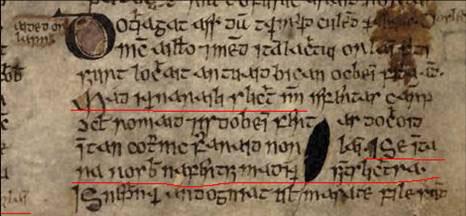
The LU text often uses the term slicht in this apparently technical sense against the readings of other MSS of Recension 1. This might suggest a stronger interest in this manuscript in openly specifying and defining the materials employed. For example, the term appears in its title to the 'Finding of the Bull', given in this manuscript only as 'Fagbáil in Tairb iarsin slicht sa so sís'. It is clearly marked as an organising feature within the layout of the manuscript, enclosed by a prominent red box.
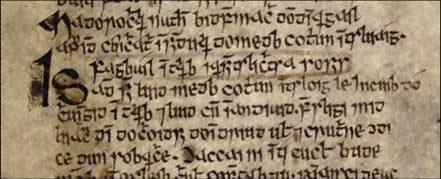
Among other instances in which the LU text employs the term slicht, in contrast to the readings of the other MSS of Recension 1, is a variant version given as part of Aided Cáuir declaring that 'Combad i nImslige Glendamnach dano dofáethsad Cáur iar n-araile slicht; according to another slicht it was in the battle of Imslige Glendamnach that Cúr fell' (O'Rahilly, 1976, 53 & 173).
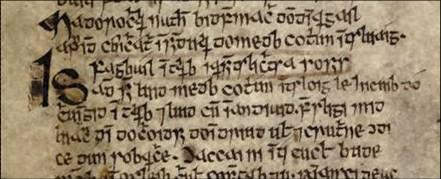
Elsewhere in LU the term refers even more pointedly to other textual sources; in the closing sections of Togail Bruidne Da Derga, for example, we are given an abbreviated version of the tale, in which a direct attribution to Cín Dromma Snechta is emphasised by a similarly visually-marked titular form: Slicht Libair Dromma Snechta inso, again enclosed within a red box.
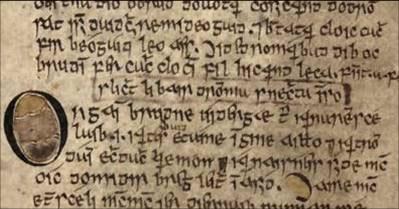
The closing section of the passage sums up the preceding material using the term slicht again, placing it among a selection of terms that appear to be bound up with medieval Irish scholars' technical and theoretical approach to the nature of their literary materials. The colophon reads:
Conid Bruden úi Derga cona fúasaitib 7 cona slechtaib 7 cona remscélaib, amal adfiadar il-lebraib insin anúas a bith samlaid…
So that is the Hostel of Húa Derga with its developments and its recensions and its foretales, as that is related in books above, its being thus… (Bergin and Best, 1929, 245).

Fúasait - 'unfolding, developing, setting out' - is a term which appears to have a specific use in critical contexts; it is used elsewhere as an equivalent or synonym for remscél 5, and seems to be employed in comparable positions to the Latin praefatio or prologus; remscél also has an obvious part to play in the Irish vocabulary of textual description. Clearly, the use of slicht in this context indicates that there is some specificity in the way it is being used, and demonstrates that the concept was able to play a part both in the critical evaluation of textual materials, and in the division and classification of texts which can be associated with compilatio and ordinatio.
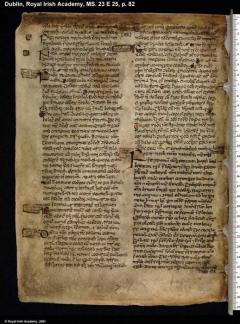
At this point, we can turn to examine some instances of visual features suggestive of compilatio and ordinatio employed as textual organising tools in TBC. One of the most striking features of Recension 1 as opposed to Recension 2, and in particular of the LU text, is a much more extensive occurence of short segments of narrative presented as independent sections, and the deployment of tituli which are visually marked in some way or other. Some of these clearly belong to the original layout; others, however, appear to be have been added by later hands. A particularly rich example is fo.82 of LU, the final page of its text of TBC
This incorporates a number of tituli for the sections Imroll Belaig Eóin inso (The Mis-Throw at Belach Eóin), Aided Tamuin Drúith inso (The Death of Taman the Jester), Aided Óengussa meic Óenláma (The Death of Óengus mac Óenláime), Comrac Fergusa fri Coin Culaind (The Meeting of Fergus with Cú Chulainn), and Comrac Maind (The Fight with Mand).
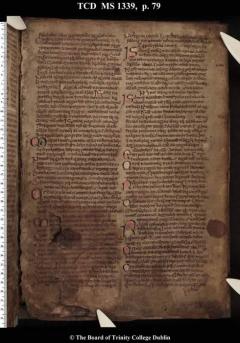
Although much comparable material is present on the corresponding page from LL, its presentation is considerably less prominent.
The fight with Mand does not appear at all, while the death of Óengus mac Óenláime and the meeting of Fergus with Cú Chulainn are incorporated into the main text with no distinguishing tituli. Although the episodes of the Mis-throw at Belach Eóin and the Death of Taman the Jester do appear as individual sections, their tituli are much less distinctively placed; the heading given for the Death of Taman, Tuige im Thamon and so inossa, is barely distinguished from the remainder of the text at all.
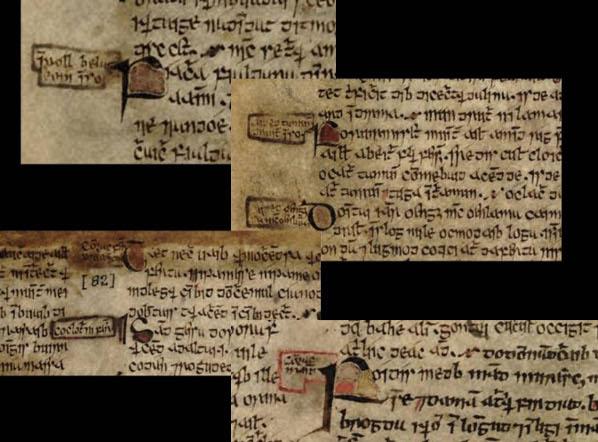
The more marked presentation of tale sections and tituli in LU, whether present as part of the original layout, or added in later revisions of the material, creates at least two effects. Firstly, it heightens the impression that the material is composite rather than comprising a running narrative; secondly, it is considerably easier for the reader to identify the different elements of the narrative. It betrays a concern with the composition of the text which is considerably less visually apparent, by comparison, in LL.
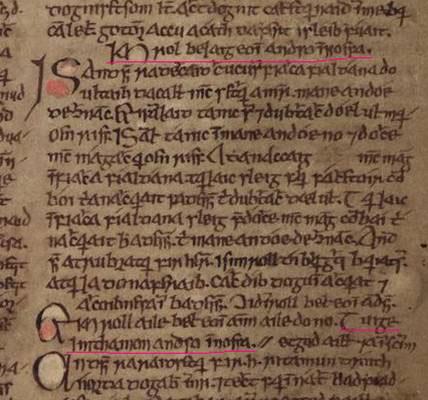
The use of tituli as an overt organisational strategy in Recension 1 can also be seen in the section Dinda na Tána, which appears after LU breaks off. The YBL presentation of the text contains a full listing of the ensuing sections, in the form of tale titles, appearing in a section preceding the material itself; each section is then marked with its own titulus. One can clearly see the different form employed to mark the tituli: in this case, a vertical line at each side rather than the full box found in LU.
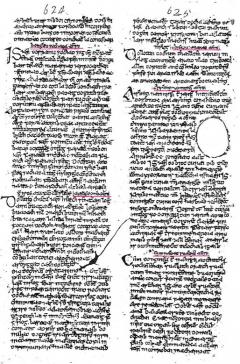
In functional terms, this is remarkably similar to the compilatory techniques outlined by Minnis (1979, 385), in which contents pages or tables precede material divided and subdivided according to subject matter, guiding the reader through the text. Given the obvious awareness of structure displayed by such features, one might wonder whether the interest shown by manuscript producers in delineating precisely what does and does not belong within the remit of TBC could also count as a medieval Irish response to these organisational concerns. This can be seen, for example, in the discussion of foretales found in the LL text of the Finding of the Tain:
Is he-seo turem remscéla Tána bó Cualngi, .i. a dó déc, .i. de Gabáil in t-shíd(a), de Aslingi in Meic Óic, de Chophur na da muccida, de Tháin bó Regamain, de Echtra Nerai, de Chompirt Chonchobair, de Thochmurc (Ferbe), de Chompirt Conculaind, de Thain bó Flidais, de Thochmurc Emiri. Atberat dana is di remscelaib de Thecht Conculaind do thaig Culaind cherdda, de Gabail gascid do Choinchulaind, acus dia dul i carpat, dia hald Cúchulaind do Emain Macha cosna maccu. Acht is i curp na tána adfiadtar na tri sceóil dedencha sa.
This is an enumeration of the fore-tales to Táin Bó Cuailnge, that is, twelve, that is, The Taking of the Síd, The Dream of the Mac Óc, The Copur of the Two Swineherds, The Cattle Raid of Regamon, The Adventure of Nera, The Begetting of Conchobar, The Courtship of Ferb, The Begetting of Cú Chulainn, The Cattle Raid of Flidais, The Courtship of Emer. Some say, moreover, that to the foretales belong the going of Cú Chulainn to the house of Culann, the Smith, the taking up of arms by Cú Chulainn and his going into a chariot, when Cú Chulainn went to Emain Macha to the boys. But it is in the main body (corp) of the Táin that these last three tales are related (Windisch 1905, liii-liv).
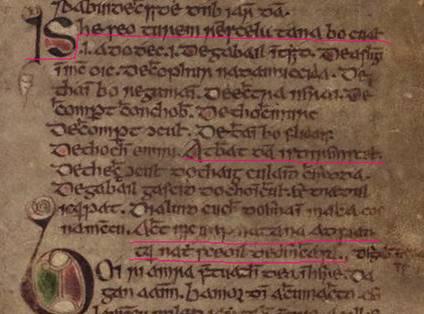
It is possible to discern similar classificatory concerns within the texts of TBC themselves, for example in the distinction drawn in Recension 1 between the prefatory material, identifed as the 'titulrad' and the main body of the story, which is defined within the text as 'in scél iar n-urd' and then introduced with a visually marked interlinear titulus designating the material that follows as 'In scél iar n-urd inso sís' (O'Rahilly, 1976, 5 & 128)
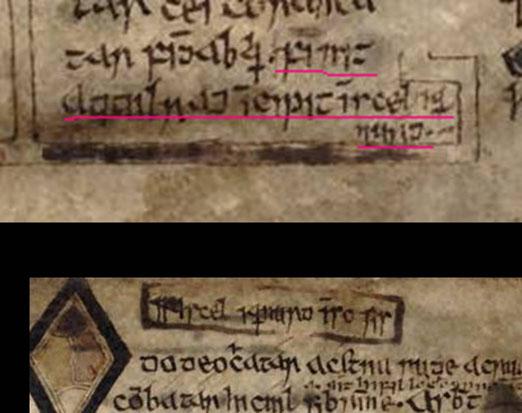
Comparable organisational concerns are also apparent in the LL version of TBC, in which a similar distinction is made between material that precedes and material that belongs to the 'story proper'. The opening sections of the LL text, containing the 'Pillow-talk' material not found in Rec.1, as well as the prophecy made by Fedelm that is classified as part of the titulrad in Rec.1, are summed up in the closing lines with an indication that they should be seen as a discrete section of the narrative:
Tairngire 7 remfástini 7 cendphairt in sceóil 7 fotha a fagbála 7 dénma, 7 comrád chind chercaille doringni Ailill 7 Medb i Crúachain connice sain.
Thus far the prophecy and augury, and the prelude to the tale, the basis of its invention and composition, and the pillow-talk held by Ailill and Medb in Cruachu (O'Rahilly, 1984, 8 & 145).
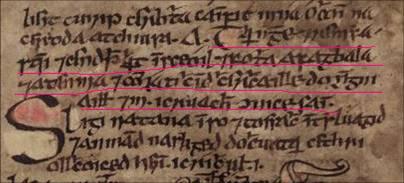
A futher distinction between sections of the text is created by the maintenance of the boundary between the 'Boyhood Deeds' and the main text, already seen in Recension 1 and repeated here in LL with variations in the terminology used to designate the core part of the narrative:
Conid innisin do macgnímaib Con Culaind sin for Táin Bó Cúalnge, ocus remthús in sceóil 7 imthechta in tslúaig a Crúachain connici sin. In scél fodessin is ní and fodechtsa.
Thus far then is some account of the youthful deeds of Cú Chulainn on the Cattle-raid of Cúailnge, together with the prologue of the tale and an account of the route and march of the host out of Crúachu. The story proper is what follows now (O'Rahilly, 1984, 33 & 171)

This concentration on the marking out of distinctions between different parts of the narrative, both within the text and with the use of visual markers, suggests an interest in structural aspects of the arrangement and organisation of textual material that corresponds to that reflected in medieval descriptions of ordinatio as a literary discipline.
As discussed above, another important aspect of compilatio and ordinatio-related textual design was the development and use of visual cues to highlight and to facilitate reference to specific features of the text. In examining the various MSS of TBC, it becomes evident that the items the producers of texts of the Táin chose to mark in this way are not necessarily those upon which modern scholars have focused in any particular detail. The most visually striking interventions in the presentation of the text emerge as a technique of formatting the various lists which occur at different moments in the narrative. Thus the list of locations through which the Connachta pass on their way to Cúailnge in the titulrad is laid out in divided columns in both LU and LL.
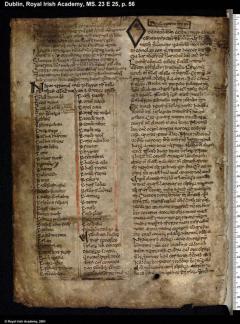
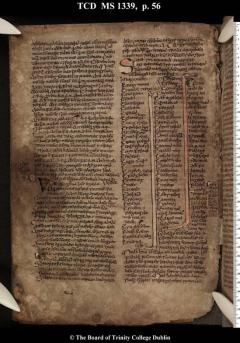
In LU, Cú Chulainn's list of feats is also placed in an organised table, with its own side-title, 'Turim na cless inso sís'
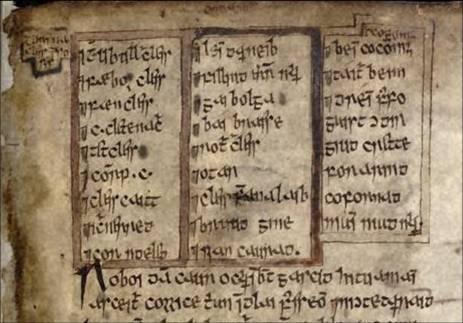
Again, in both LU and LL the list of those who fell in the battle of Sesrech Breslige is similarly highlighted.
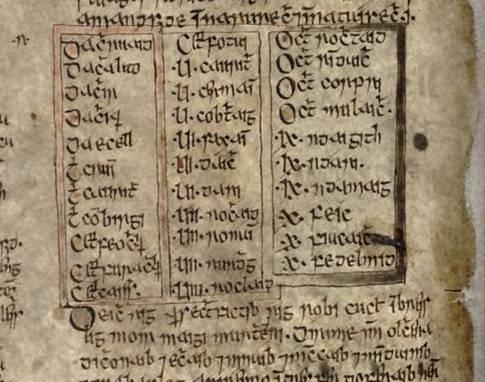
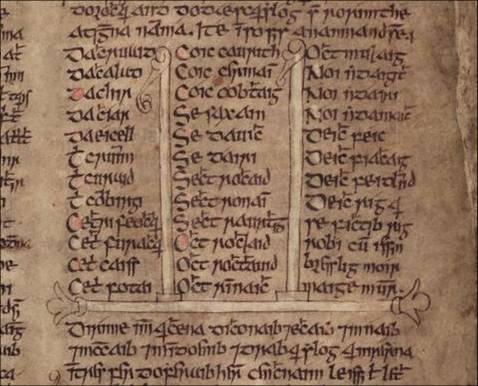
In YBL, again after the text of LU breaks off, the Muster of the Ulstermen is conspicuous in its presentation
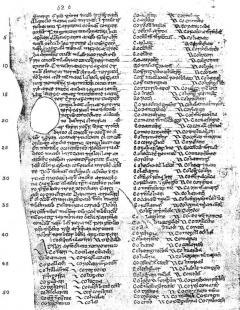
LL too utilises display script and formatting to present the list
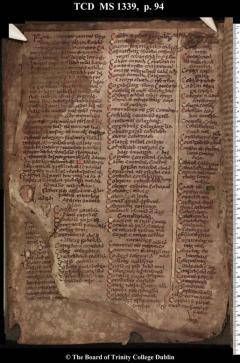
Should this be read as an indication of the anticipated interests of the readership of the material? Are readers expected to look up familiar names and places? Is it a visual aid to the memorisation of information? Whatever may be the case, the occurrence of these traits surely serves as a warning that one should not overlook these organisational aspects of early Irish texts when attempting to envisage their contemporary placement and reception.
Martin Irvine's reflects as follows on the need to include notions of compilatio in our assessment of the function of writing, the nature of authorship and of textuality in the Middle Ages: 'The form of textuality at work can be understood through the notion of writer as compilator, one who selects material from a larger cultural library and whose resulting compilation is an interpretive arrangement of the discursive traditions in which the writer intervenes... The compiler sets up a dialogue between prior texts and the interpretive discourse of his own community, isolating or bringing into focus the larger network of texts that forms the library' (Irvine, 1994, 241-2). Such an assessment is surely also valid for early Irish manuscript culture, which might additionally be open to the inclusion of oral literary material within the 'cultural library' upon which the compiler draws. Future research might profitably be directed towards investigating in greater detail how this 'dialogue' diverges in different texts of the Táin. In particular, further study should throw light upon the contrasting attitudes of the scribes of Recensions 1 and 2 with regard to how they envision and structure their relationships to the material they record.
The evidence of compilatio techniques in manuscripts of TBC provides valuable insight into how the creators of these texts regarded the task of managing and presenting their material. Clearly, we should be careful not to hold as self-evident the development and production of the texts in their present form; if we do, we are liable to overlook and misjudge the subtleties and refinements of their stance towards the material they represent. As a preliminary venture, I offer here two suggestions to show how the inclusion of medieval ideas of compilatio within broader scholarly perspectives upon the texts of Táin Bó Cúailnge could affect our view of their contents. Firstly, scholars and critics tend to think of the LL Táin as rather more resolved and 'writerly' than Recension 1. Treating Recension 1, or perhaps rather its individual manuscript versions, as a conscious example or examples of compilatio enables us to assess it as a comprehensive work on its own terms, bypassing the fixation with 'lack of unity' which characterised early twentieth-century approaches to medieval Irish literature. In his epitomisation of Sextus Pompeius Festus' glossary De verborum significatu, Paul the Deacon defines compilare as follows: compilare cogere est et in unum condere, 'to compile is to bring together and to put into one' (Lindsay, 1933, 35). Certainly, the impression given by Recension 1 is that it is informed by a concern to portray its material as being as exhaustively complete as possible. This, if correct, simply betrays a different set of literary priorities from those expected by modern scholars in search of the 'unified' text.
To take up the position of compilator with respect to a corpus of material implies a deep and wide-ranging familiarity with it, and the ability to make qualitative and critical judgements concerning its arrangement. It also permits detachment: as has been demonstrated in the quotation from St Bonaventure above, no personal responsibility for the contents is involved. This would appear to be a rather convenient position for clerical scribes to adopt when working on material describing a pre-Conversion world. They had a prestigious precedent in the shape of Isidore of Seville, who, as we have seen, identified Vergil as being the compiler of his works rather than their creator. It may also have some resonance in the much commented-on colophon to the LL Táin. Many scholars, including the present writer, have tended to focus upon the second section, which evaluates the content of the text and to some degree distances the writer from responsibility for the material. But the LL compiler introduces this piece of critical assessment by taking ownership of, and claiming some status for, the form and arrangement of the text, giving a 'bendacht ar cach óen mebraigfes go hindraic Táin amlaid seo 7 ná tuillfe cruth aille furri: a blessing on everyone who shall faithfully memorise the Táin like this and shall not add any other form to it' (O'Rahilly 1984, 136 & 272). The Recension 1 Táin's use of technical vocabulary and formatting, and its more overt interest in defining and arranging its ordinatio partium, is easier to relate to the compilatory tradition of medieval grammatica. Nevertheless, it is tempting to ask whether the creator of the LL text may also be showing an awareness here of some of the advantages and freedoms that invoking the status of compilatio might confer on his material.
Bibliography
Atkinson, R. (1896) The Yellow Book of Lecan. Dublin.
Bergin, O. and Best, R. I. (1929) Lebor na hUidre. Dublin.
Bonaventure, St., In primum librum sententiarum, see Quaracci (1882).
Isidore of Seville, Etymologiae, see Lindsay (1911).
Dagenais, J (1993) The Ethics of Reading in Manuscript Culture: Glossing the Libro de Buen Amor. Princeton.
Ford, P. (1996) 'Medieval Irish Manuscript Culture' Field Work: Sites in Literary and Cultural Studies, ed. Marjorie Garber, Paul B Franklin and Rebecca L Walkowitz, 164-168. New York & London.
Gilbert, J.J., and J. O'Longan, (1872-6) Leabhar Breac (Lithograph facsimile). Dublin. Hinton, Norman D., (1984) '"The Canterbury Tales" as Compilatio', Essays in Medieval Studies 1, 28-48.
Irvine, Martin (1994) The Making of Textual Culture. Cambridge.
Lindsay, W.M. (1911) Isidore of Seville Etymologiae sive Origines 2 vols. Oxford.
_________ (1913) Sextus Pompeius Festus, De verborum significatu cum Pauli epitome. Leipzig.
Mac Eoin, Gearóid (1994) 'The interpolator H in Lebor na hUidre', Ulidia, ed. J.P. Mallory and Gerard Stockman, 39-46. Belfast and Emain Macha.
Macrobius, Saturnalia, see Willis (1970)
O'Grady, S.H. and Flower, R. (1926) Catalogue of Irish Manuscripts in the British Museum, Vol. II. London.
Minnis, A.J. (1979) 'Late Medieval Discussions of Compilatio and the Rôle of the Compilator', Beiträge zur Geschichte der Deutschen Sprache und Literatur 101, 385-421.
O Concheanainn, Tomas (1984) 'LL and the Date of the Reviser of LU.' Eigse 20, 212-225.
O'Rahilly, C. (1976) Táin Bó Cúailnge Recension 1. Dublin.
_______ (1984) Táin Bó Cúailnge from the Book of Leinster. Dublin.
Parkes, M.B. (1976) 'The Influence of the Concepts of Ordinatio and Compilatio on the Development of the Book', in Medieval Learning and Literature, Essays presented to Richard William Hunt, ed. J.J.G. Alexander and M. T. Gibson, 115-141. Oxford.
Paul the Deacon, De verborum significatu, see Lindsay (1913).
Quaracci, I. (1882) S. Bonaventura Opera Omnia vol. 1. Rome.
Rowse, R.H. and Rowse, M.A. (1992) 'Ordinatio and Compilatio Revisited', in Ad Litteram: Authoratative Texts and their Medieval Readers, ed. M. D. Jordan and Kent Emery Jr., 113-134. Notre Dame and London.
Thurneysen, R., (1921) Die Irischen Helden- und Konigsage bis zum siebzehnten Jahrhundert. Halle (Salle).
Willis, James (1970) Macrobius' Saturnalia. Leipzig.
Windisch, E. (1897) 'Tochmarc Ferbe', in Irische Texte III/2, 445-548. Leipzig.
Windisch, E. (1905) Die altirische Heldensage Táin Bó Cúalnge nach dem Buch von Leinster. Leipzig.
Zimmer. H. (1887) 'Über den compilatorischen charakter der irischen sagentexte im sogenannten Lebor na hUidre', Zeitschrift für vergleichende Sprachforschung xxviii, 426-554.
Endnotes
1 See, for instance, Zimmer (1887, 426-554), Thurneysen (1921, 101-05), O'Rahilly (1976, vii - xvii).
2 'Quadruplex est modus faciendi librum. Aliquis enim scribit aliena, nihil addendo vel mutando, et iste mere dicitur scriptor. Aliquis scribit aliena addendo, sed non de suo; et iste compilator dicitur. Aliquis scribit et aliena et sua, sed aliena tamquam principalia, et sua tamquam annexa ad evidentiam, et iste dicitur commentator non auctor. Aliquis scribit et sua et aliena, sed sua tamquam principalia, aliena tamquam annexa ad confirmationem et debet dici auctor' (Quaracci 1882, 14).
3 Dagenais' use of scriptum as a term that can represent conveniently the interpretative aspects of the scribes' input as well as the texts found in individual manuscript copies places considerable emphasis upon the role of the scribe or writer as reader and commentator. In stressing the significance of the status of these individual versions of textual material as opposed to the 'text' which they represent, he draws our attention to the profound differences between the cumulative, collaborative nature of medieval literary tradition, and the accompanying characteristics of textual production in a manuscript-based culture, and the author-text model familiar from printed literary culture. '"Scriptum" signifies a concrete, unique, unduplicatable, physical manuscript together with the writing, both textual and trivial, it contains. It exists in opposition to the Letter, the infinitely replicable text that, freed from its physical support, serves as the basis of most forms of postmedieval discourse about both literature and scripta' (Dagenais, 1994, 20). Ford emphasises the relevance of this approach to the study of medieval Irish texts, reminding us that the early Irish manuscript record provides us with evidence of a literary culture in which manuscripts were glossed, added to, subtracted from, and otherwise worked on, and in which the activities of the reader are as worthy of notice as those of the author: 'Individual versions of a text allow us to examine the mind of the medieval scribe/scholar at work and, in the process, to acquaint ourselves with medieval Irish readers and literary process' (1996, 167).
4 For discussion of the identity and activity of 'H', see Best (1912 and 1929, xiv-xxiii), Thurneysen (1921, 31, 594-5), Ó Concheannainn (1974), O'Rahilly (1976, vii-xviii), and Mac Eoin (1994).
5 The term is used in Tochmarc Ferbe to identify the text as prefatory material to Táin Bó Cúailnge: 'co mbad fúasait don táin in scél so' (Windisch, 1897, 548). In Lebor Breac 238db 56-57, it is used as an even more obvious equivalent to praefatio, discussing the attribution of the preface to Amra Choluimb Chille: 'fúasait and so dorígned do Colum Cille in bec sa sís conice 'ni dis'.'

